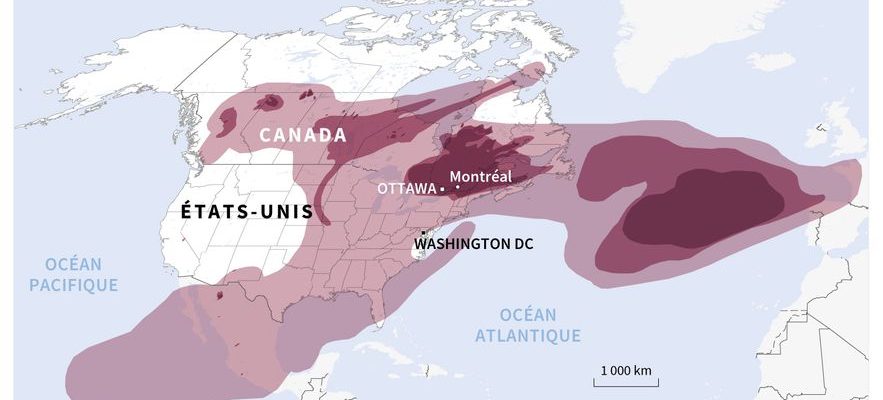The intense forest fires ravaging Canada caused huge clouds of ash that covered Montreal (Quebec), Sunday, June 25. Canadian authorities have issued several alerts to warn the inhabitants of the affected regions, in particular the most vulnerable people, and even canceled sports competitions, including two triathlons. Propelled into the atmosphere at very high altitude, the fine particles generated by the fires traveled several thousand kilometers above the Atlantic Ocean and reached France on Monday May 26.
“The model developed at Météo-France, named MOCAGE, simulates the transport over the Atlantic of fine particles emitted by fires in Canada. The first particles are already over France today and should remain above our territory until the disturbance which will pass on Thursday causes a washing out of the atmosphere thanks to the clouds and the rain”, specifies Météo France to L’Express. Nevertheless, many uncertainties remain concerning the concentration of these particles as well as their altitude. If these remain high in the atmosphere, the consequences should be minimal, if any. But if they are concentrated and low, there will be health risks, explains Doctor Pierre Souvet, cardiologist and founding president of the Association Santé Environnement France (ASEF).
The cloud of smoke from the fires in Canada
© / afp.com/Gal ROMA, Sabrina BLANCHARD
The Express. What components are released into the atmosphere when a forest burns?
Pierre Souvet. More than 4,000 components have been identified by the researchers, including dioxins – certain carcinogens -, heavy metals, furans and polycyclic aromatic hydrocarbons (PAH): benzene, styrene, carbon particles, monoxide, methane, mercury, etc. These components present in smoke stick to the fine particles in the atmosphere and make them even more toxic.
What happens when we breathe them in?
Larger particles are blocked by the ears, mouth and nose. But the finest can penetrate the lungs, the blood, even the brain.
What are the short-term health consequences?
People directly exposed to fumes – those in close proximity to fires and smoke – may experience signs of nasal, eye and throat irritation, headaches, respiratory discomfort such as wheezing, and even associated pain. to deep breathing. A study published in 2011 shows, for example, that the Corsican firefighters who were poorly protected during their interventions experienced significant short-term effects with a loss of their “forced vital capacity” (the maximum quantity of air that one can exhale after having inhaled deeply) of more than half a litre. And these effects can persist for up to three months after the fire season.
What are the consequences for people who are not necessarily directly exposed to fires, but who still breathe fine particles?
It depends on the concentration of fine particles in the air. But the main effects observed are an increase in ENT disorders, therefore of the throat, nose, larynx. When there are peaks of pollution with fine particles – whether they come from forest fires or pollution – there are more asthma attacks, episodes of coughing, shortness of breath, chest pain. This is what the Canadian Department of Health is currently observing. It is also known that fine particles cause a decrease in immune defenses in the lungs, which makes those affected more susceptible to future infections.
A scientific study conducted in 2014 explains that an increase of 10 micrograms per cubic meter of fine particulate matter (PM2.5) is associated with a 42% increase in the number of ambulance calls for respiratory problems. These results were confirmed by another study on the impact of exposure to smoke from Australian fires in 2019-2020, which indicates that emergency room visits and hospitalizations, mainly for respiratory problems, increased by 1.4 to 17% depending on the areas affected.
Other scientific work suggests that exposure to fine particles from road traffic can cause short-term cardiovascular and neurovascular problems. Indeed, these particles cause inflammation of the blood vessels, which can promote the risk of myocardial infarction (heart attack) and cerebrovascular accidents (CVA). A meta analysis [une compilation d’études scientifiques, NDLR] realized in 2015 concludes that each time the level of fine particles (PM2.5) increases by 10 micrograms per cubic meter of air, the risk of stroke increases by about 1%. Forest fires are therefore suspected of causing the same effects, but for the moment, studies on the subject are still too rare, so further research will be needed to prove it.
And what are the longer term effects?
We know that many PAHs released by fires have a carcinogenic effect. But it remains difficult to calculate their influence in the triggering of possible cancers, in particular because it is complicated to differentiate the effect of PAHs resulting from fires from those resulting from human pollution.
How can you best protect yourself from these fine particles?
One thing is certain, we must protect ourselves from pollution peaks of fine particles. It will therefore be necessary to monitor the alerts of the authorities over the next few days in order to know if the cloud is low in the atmosphere or not. If so, the general recommendation is to avoid strenuous activity, stay home with windows closed, and report your symptoms to your doctor. Masks can also be a solution. According a meta analysis published in December 2021, surgical masks and FFP2, even if they are not perfectly fitted, can filter between 20% and 70% of fine particles, with a better result for FFP2. Even cloth masks and bandanas could provide some protection.
These recommendations apply to everyone, but more particularly to people at risk: pregnant women, children, the elderly, not forgetting all those who suffer from cardiovascular disorders, cancer or diabetes (one in seven diabetes is linked to air pollution, which promotes inflammation of the system that allows glycemic balance). Canadian authorities are also warning smokers, people who work outdoors and sports enthusiasts.
